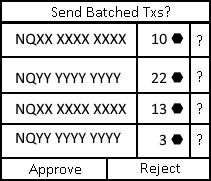Multiple recipient support sounds really cool! I was actually curious about whether we could see Batched Transactions in some way in the future (each tx itself would still be a standard single recipient tx, but each with it’s own value and message)? I didn’t want to bring it up yet as personally I want the basic tx + signature version of the Keyguard ASAP (absolutely so excited for what even the first form will do for the ecosystem), but I think if we could send a batch of TXs for the user to review and approve / reject as a whole* a lot could be done with Nimiq. Far more than just requesting the user send 2 txs so a fee can be taken in a somewhat decentralized way, I think the potential for advanced centralized logic (but all initiated/related to on chain txs that the user fully controls) in applications would be possible.
* - If one wants to send a batch of txs with the user approving / rejecting certain ones, I would expect that dev to use the standard request process on tx at a time, I see Batched Txs more for something where the multiple txs must be sent or none get sent as logic on the requester’s side depends on the multiple txs.
Even something as simple as (just an example) Nimiq Webtip allowing the website to specify multiple addresses and percentages for each developer of the site, and you clicking the “Tip” button in Nimiq Webtip requesting you approve the batch of txs (maybe you Tip 5 NIM which get’s split into 3 txs of 2 ⬣, 2.5 ⬣, and 0.5 ⬣ to the 3 devs). This example is also perfect to show why batched txs would need to be approved / rejected as a whole batch, and not treated as a group of txs grouped for UX convenience but accepted/rejected on a per tx basis. It’d be important that the batch be treated as needing only one approval / rejection as you wouldn’t want the user only approving a donation to 2 of the 3 devs that the site has in it’s JSON file, etc…

An example of what I’m talking about. The ? would be clicked on to see what the data of the TX is (since I assume 90% of the time [at least early on in our ecosystem’s lifetime] you’ll only care to check that your money isn’t being stolen by an extra Tx in the batch rather than whether the data being sent is accurate), and the Amount would probably need to be in both ⬣ and ☾ or use decimal places but I just threw this picture together in paint, and didn’t put a ton of thought into the UI needed.

 ).
).